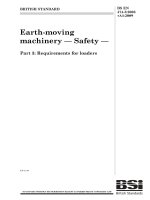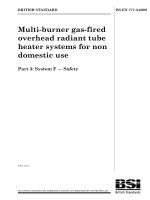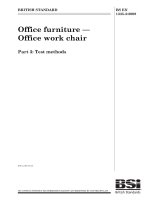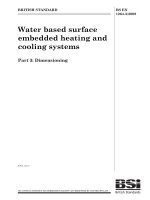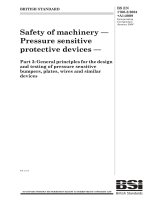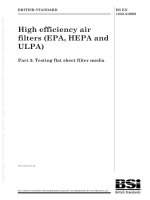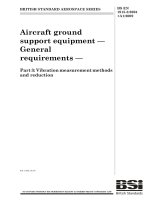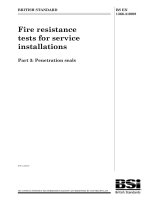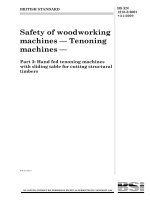Bsi bs en 60300 3 11 2009
Bạn đang xem bản rút gọn của tài liệu. Xem và tải ngay bản đầy đủ của tài liệu tại đây (1.28 MB, 52 trang )
Licensed copy: The University of Hong Kong, The University of Hong Kong, Version correct as of 24/01/2010 03:44, (c)
BSI
BS EN 60300-3-11:2009
BSI Standards Publication
Dependability management —
Part 3-11: Application guide — Reliability centred
maintenance
NO COPYING WITHOUT BSI PERMISSION EXCEPT AS PERMITTED BY COPYRIGHT LAW
raising standards worldwide™
Licensed copy: The University of Hong Kong, The University of Hong Kong, Version correct as of 24/01/2010 03:44, (c)
BSI
BRITISH STANDARD
BS EN 60300-3-11:2009
National foreword
This British Standard is the UK implementation of EN 60300-3-11:2009. It is
identical to IEC 60300-3-11:2009.
The UK participation in its preparation was entrusted to Technical Committee
DS/1, Dependability and terotechnology.
A list of organizations represented on this committee can be obtained on
request to its secretary.
This publication does not purport to include all the necessary provisions of a
contract. Users are responsible for its correct application.
© BSI 2010
ISBN 978 0 580 56314 0
ICS 03.100.40; 03.120.01
Compliance with a British Standard cannot confer immunity from
legal obligations.
This British Standard was published under the authority of the Standards
Policy and Strategy Committee on 31 January 2010
Amendments issued since publication
Amd. No.
Date
Text affected
Licensed copy: The University of Hong Kong, The University of Hong Kong, Version correct as of 24/01/2010 03:44, (c)
BSI
BS EN 60300-3-11:2009
EUROPEAN STANDARD
EN 60300-3-11
NORME EUROPÉENNE
November 2009
EUROPÄISCHE NORM
ICS 03.100.40; 03.120.01
English version
Dependability management Part 3-11: Application guide Reliability centred maintenance
(IEC 60300-3-11:2009)
Gestion de la sûreté de fonctionnement Partie 3-11: Guide d'application Maintenance basée sur la fiabilité
(CEI 60300-3-11:2009)
Zuverlässigkeitsmanagement Teil 3-11: Anwendungsleitfaden Auf die Funktionsfähigkeit bezogene
Instandhaltung
(IEC 60300-3-11:2009)
This European Standard was approved by CENELEC on 2009-09-01. CENELEC members are bound to comply
with the CEN/CENELEC Internal Regulations which stipulate the conditions for giving this European Standard
the status of a national standard without any alteration.
Up-to-date lists and bibliographical references concerning such national standards may be obtained on
application to the Central Secretariat or to any CENELEC member.
This European Standard exists in three official versions (English, French, German). A version in any other
language made by translation under the responsibility of a CENELEC member into its own language and notified
to the Central Secretariat has the same status as the official versions.
CENELEC members are the national electrotechnical committees of Austria, Belgium, Bulgaria, Cyprus, the
Czech Republic, Denmark, Estonia, Finland, France, Germany, Greece, Hungary, Iceland, Ireland, Italy, Latvia,
Lithuania, Luxembourg, Malta, the Netherlands, Norway, Poland, Portugal, Romania, Slovakia, Slovenia, Spain,
Sweden, Switzerland and the United Kingdom.
CENELEC
European Committee for Electrotechnical Standardization
Comité Européen de Normalisation Electrotechnique
Europäisches Komitee für Elektrotechnische Normung
Central Secretariat: Avenue Marnix 17, B - 1000 Brussels
© 2009 CENELEC -
All rights of exploitation in any form and by any means reserved worldwide for CENELEC members.
Ref. No. EN 60300-3-11:2009 E
Licensed copy: The University of Hong Kong, The University of Hong Kong, Version correct as of 24/01/2010 03:44, (c)
BSI
BS EN 60300-3-11:2009
EN 60300-3-11:2009
-2-
Foreword
The text of document 56/1312/FDIS, future edition 2 of IEC 60300-3-11, prepared by IEC TC 56,
Dependability, was submitted to the IEC-CENELEC parallel vote and was approved by CENELEC as
EN 60300-3-11 on 2009-09-01.
The following dates were fixed:
– latest date by which the EN has to be implemented
at national level by publication of an identical
national standard or by endorsement
(dop)
2010-06-01
– latest date by which the national standards conflicting
with the EN have to be withdrawn
(dow)
2012-09-01
Annex ZA has been added by CENELEC.
__________
Endorsement notice
The text of the International Standard IEC 60300-3-11:2009 was approved by CENELEC as a European
Standard without any modification.
In the official version, for Bibliography, the following notes have to be added for the standards indicated:
IEC 61164
NOTE Harmonized as EN 61164:2004 (not modified).
IEC 61649
NOTE Harmonized as EN 61649:2008 (not modified).
IEC 61709
NOTE Harmonized as EN 61709:1998 (not modified).
IEC 62308
NOTE Harmonized as EN 62308:2006 (not modified).
ISO 9000
NOTE Harmonized as EN ISO 9000:2005 (not modified).
__________
Licensed copy: The University of Hong Kong, The University of Hong Kong, Version correct as of 24/01/2010 03:44, (c)
BSI
BS EN 60300-3-11:2009
-3-
EN 60300-3-11:2009
Annex ZA
(normative)
Normative references to international publications
with their corresponding European publications
The following referenced documents are indispensable for the application of this document. For dated
references, only the edition cited applies. For undated references, the latest edition of the referenced
document (including any amendments) applies.
NOTE When an international publication has been modified by common modifications, indicated by (mod), the relevant EN/HD
applies.
Publication
Year
Title
EN/HD
Year
IEC 60050-191
1990
International Electrotechnical Vocabulary
(IEV) Chapter 191: Dependability and quality of
service
-
-
IEC 60300-3-2
-
1)
Dependability management Part 3-2: Application guide - Collection of
dependability data from the field
EN 60300-3-2
2005
IEC 60300-3-10
-
1)
Dependability management Part 3-10: Application guide - Maintainability
-
-
IEC 60300-3-12
-
1)
Dependability management Part 3-12: Application guide - Integrated
logistic support
EN 60300-3-12
2004
2)
IEC 60300-3-14
-
1)
Dependability management Part 3-14: Application guide - Maintenance
and maintenance support
EN 60300-3-14
2004
2)
IEC 60812
-
1)
Analysis techniques for system reliability Procedure for failure mode and effects
analysis (FMEA)
EN 60812
2006
2)
1)
Undated reference.
2)
Valid edition at date of issue.
2)
Licensed copy: The University of Hong Kong, The University of Hong Kong, Version correct as of 24/01/2010 03:44, (c)
BSI
BS EN 60300-3-11:2009
–2–
60300-3-11 © IEC:2009
CONTENTS
INTRODUCTION .....................................................................................................................6
1
Scope ...............................................................................................................................7
2
Normative references........................................................................................................7
3
Terms, definitions and abbreviations .................................................................................7
4
3.1 Definitions ...............................................................................................................8
3.2 Abbreviations......................................................................................................... 11
Overview ........................................................................................................................ 11
5
4.1
4.2
4.3
RCM
6
5.1 Objectives for conducting an RCM analysis ............................................................ 15
5.2 Justification and prioritization ................................................................................. 16
5.3 Links to design and maintenance support............................................................... 16
5.4 Knowledge and training.......................................................................................... 17
5.5 Operating context .................................................................................................. 17
5.6 Guidelines and assumptions .................................................................................. 18
5.7 Information requirements ....................................................................................... 19
Functional failure analysis ............................................................................................... 20
General ................................................................................................................. 11
Objectives ............................................................................................................. 12
Types of maintenance............................................................................................ 14
initiation and planning ............................................................................................ 15
6.1
6.2
7
Principles and objectives ....................................................................................... 20
Requirements for definition of functions ................................................................. 20
6.2.1 Functional partitioning ................................................................................ 20
6.2.2 Development of function statements........................................................... 20
6.3 Requirements for definition of functional failures .................................................... 21
6.4 Requirements for definition of failure modes .......................................................... 21
6.5 Requirements for definition of failure effects .......................................................... 22
6.6 Criticality ............................................................................................................... 22
Consequence classification and RCM task selection ....................................................... 23
7.1
7.2
7.3
7.4
7.5
8
Principles and objectives ....................................................................................... 23
RCM decision process ........................................................................................... 23
Consequences of failure ........................................................................................ 26
Failure management policy selection...................................................................... 26
Task interval.......................................................................................................... 27
7.5.1 Data sources ............................................................................................. 27
7.5.2 Condition monitoring .................................................................................. 28
7.5.3 Scheduled replacement and restoration...................................................... 29
7.5.4 Failure finding ............................................................................................ 30
Implementation ............................................................................................................... 30
8.1
8.2
8.3
8.4
8.5
8.6
8.7
Maintenance task details ....................................................................................... 30
Management actions.............................................................................................. 30
Feedback into design and maintenance support ..................................................... 30
Rationalization of tasks .......................................................................................... 33
Implementation of RCM recommendations ............................................................. 34
Age exploration ..................................................................................................... 34
Continuous improvement ....................................................................................... 34
Licensed copy: The University of Hong Kong, The University of Hong Kong, Version correct as of 24/01/2010 03:44, (c)
BSI
BS EN 60300-3-11:2009
60300-3-11 © IEC:2009
–3–
8.8 In-service feedback ............................................................................................... 35
Annex A (informative) Criticality analysis .............................................................................. 37
Annex B (informative) Failure finding task intervals............................................................... 40
Annex C (informative) Failure patterns ................................................................................. 42
Annex D (informative) Application of RCM to structures ........................................................ 44
Bibliography .......................................................................................................................... 47
Figure 1 – Overview of the RCM process ............................................................................... 12
Figure 2 – Evolution of an RCM maintenance programme ...................................................... 14
Figure 3 – Types of maintenance tasks ................................................................................. 15
Figure 4 – Relationship between RCM and other support activities......................................... 17
Figure 5 – RCM decision diagram .......................................................................................... 25
Figure 6 – P-F Interval .......................................................................................................... 28
Figure 7 – ILS management process and relationship with RCM analysis ............................... 32
Figure 8 – Risk versus cost considerations for rationalization of tasks ................................... 33
Figure 9 – RCM continuous improvement cycle...................................................................... 35
Figure C.1 – Dominant failure patterns .................................................................................. 42
Table A.1 – Example of a criticality matrix ............................................................................. 39
Table C.1 – Failure pattern categories and frequency of occurrence ...................................... 43
Licensed copy: The University of Hong Kong, The University of Hong Kong, Version correct as of 24/01/2010 03:44, (c)
BSI
BS EN 60300-3-11:2009
–6–
60300-3-11 © IEC:2009
INTRODUCTION
Reliability centred maintenance (RCM) is a method to identify and select failure management
policies to efficiently and effectively achieve the required safety, availability and economy of
operation. Failure management policies can include maintenance activities, operational
changes, design modifications or other actions in order to mitigate the consequences of failure.
RCM was initially developed for the commercial aviation industry in the late 1960s, resulting in
the publication of ATA-MGS-3 [1] 2. RCM is now a proven and accepted methodology used in a
wide range of industries.
RCM provides a decision process to identify applicable and effective preventive maintenance
requirements, or management actions, for equipment in accordance with the safety,
operational and economic consequences of identifiable failures, and the degradation
mechanism responsible for those failures. The end result of working through the process is a
judgement as to the necessity of performing a maintenance task, design change or other
alternatives to effect improvements.
The basic steps of an RCM programme are as follows:
a) initiation and planning;
b) functional failure analysis;
c) task selection;
d) implementation;
e) continuous improvement.
All tasks are based on safety in respect of personnel and environment, and on operational or
economic concerns. However, it should be noted that the criteria considered will depend on the
nature of the product and its application. For example, a production process will be required to
be economically viable, and may be sensitive to strict environmental considerations, whereas
an item of defence equipment should be operationally successful, but may have less stringent
safety, economic and environmental criteria.
Maximum benefit can be obtained from an RCM analysis if it is conducted at the design stage,
so that feedback from the analysis can influence design. However, RCM is also worthwhile
during the operation and maintenance phase to improve existing maintenance tasks, make
necessary modifications or other alternatives.
Successful application of RCM requires a good understanding of the equipment and structure,
as well as the operational environment, operating context and the associated systems, together
with the possible failures and their consequences. Greatest benefit can be achieved through
targeting of the analysis to where failures would have serious safety, environmental, economic
or operational effects.
___________
2
Figures in square brackets refer to the bibliography.
Licensed copy: The University of Hong Kong, The University of Hong Kong, Version correct as of 24/01/2010 03:44, (c)
BSI
BS EN 60300-3-11:2009
60300-3-11 © IEC:2009
–7–
DEPENDABILITY MANAGEMENT –
Part 3-11: Application guide –
Reliability centred maintenance
1
Scope
This part of IEC 60300 provides guidelines for the development of failure management policies
for equipment and structures using reliability centred maintenance (RCM) analysis techniques.
This part serves as an application guide and is an extension of IEC 60300-3-10, IEC 60300-312 and IEC 60300-3-14. Maintenance activities recommended in all three standards, which
relate to preventive maintenance, may be implemented using this standard.
The RCM method can be applied to items such as ground vehicles, ships, power plants,
aircraft, and other systems which are made up of equipment and structure, e.g. a building,
airframe or ship's hull. Typically, equipment comprises a number of electrical, mechanical,
instrumentation or control systems and subsystems which can be further broken down into
progressively smaller groupings, as required.
This standard is restricted to the application of RCM techniques and does not include aspects
of maintenance support, which are covered by the above-mentioned standards or other
dependability and safety standards.
2
Normative references
The following referenced documents are indispensable for the application of this document. For
dated references, only the edition cited applies. For undated references, the latest edition of
the referenced document (including any amendments) applies.
IEC 60050-191:1990, International Electrotechnical Vocabulary – Chapter 191: Dependability
and quality of service
IEC 60300-3-2, Dependability management – Part 3-2: Application guide – Collection of
dependability data from the field
IEC 60300-3-10, Dependability management – Part 3-10: Application guide – Maintainability
IEC 60300-3-12, Dependability management – Part 3-12: Application guide – Integrated logistic
support
IEC 60300-3-14, Dependability management – Part 3-14: Application guide – Maintenance and
maintenance support
IEC 60812, Analysis techniques for system reliability – Procedure for failure mode and effects
analysis (FMEA)
3
Terms, definitions and abbreviations
For the purposes of this document, the terms and definitions of IEC 60050-191 apply, together
with the following.
Licensed copy: The University of Hong Kong, The University of Hong Kong, Version correct as of 24/01/2010 03:44, (c)
BSI
BS EN 60300-3-11:2009
–8–
3.1
60300-3-11 © IEC:2009
Definitions
3.1.1
age exploration
systematic evaluation of an item based on analysis of collected information from in-service
experience to determine the optimum maintenance task interval
NOTE The evaluation assesses the item's resistance to a deterioration process with respect to increasing age or
usage.
3.1.2
criticality
severity of effect of a deviation from the specified function of an item, with respect to specified
evaluation criteria
NOTE 1 The extent of effects considered may be limited to the item itself, to the system of which it is a part, or
range beyond the system boundary.
NOTE 2
The deviation may be a fault, a failure, a degradation, an excess temperature, an excess pressure, etc.
NOTE 3 In some applications, the evaluation of criticality may include other factors such as the probability of
occurrence of the deviation, or the probability of detection.
3.1.3
damage-tolerant
capable of sustaining damage and continuing to function as required, possibly at reduced
loading or capacity
3.1.4
failure (of an item)
loss of ability to perform as required
3.1.5
failure effect
consequence of a failure mode on the operation, function or status of the item
3.1.6
failure management policy
maintenance activities, operational changes, design modifications or other actions in order to
mitigate the consequences of failure
3.1.7
function
intended purpose of an item as described by a required standard of performance
3.1.8
failure mode
manner in which failure occurs
NOTE
A failure mode may be defined by the function lost or the state transition that occurred.
3.1.9
failure-finding task
scheduled inspection or specific test used to determine whether a specific hidden failure has
occurred
3.1.10
functional failure
reduction in function performance below desired level
Licensed copy: The University of Hong Kong, The University of Hong Kong, Version correct as of 24/01/2010 03:44, (c)
BSI
BS EN 60300-3-11:2009
60300-3-11 © IEC:2009
–9–
3.1.11
hidden failure mode
failure mode whose effects do not become apparent to the operator under normal
circumstances
3.1.12
indenture level
level of subdivision of an item from the point of view of a maintenance action
NOTE 1
Examples of indenture levels could be a subsystem, a circuit board, a component.
NOTE 2 The indenture level depends on the complexity of the item’s construction, the accessibility to subitems,
skill level of maintenance personnel, test equipment facilities, safety considerations, etc.
[IEV 191-07-05:1990]
3.1.13
inspection
identification and evaluation of the actual condition against a specification
3.1.14
maintenance action
maintenance task
sequence of elementary maintenance activities carried out for a given purpose
NOTE
3.1.15
Examples include diagnosis, localization, function check-out, or combinations thereof.
tem
part, component, device, subsystem, functional unit, equipment or system that can be
individually considered
NOTE 1 An item may consist of hardware, software or both, and may also, in particular cases, include people.
Elements of a system may be natural or man-made material objects, as well as modes of thinking and the results
thereof (e.g. forms of organization, mathematical methods and programming languages).
NOTE 2 In French the term "entité" is preferred to the term "dispositif” due to its more general meaning. The term
"dispositif' is also the common equivalent for the English term "device".
NOTE 3
In French the term "individu" is used mainly in statistics.
NOTE 4
A group of items, e.g. a population of items or a sample, may itself be considered as an item.
NOTE 5
these.
A software item may be a source code,an object code, a job control code, control data, or a collection of
3.1.16
maintenance concept
interrelationship between the maintenance echelons, the indenture levels and the levels of
maintenance to be applied for the maintenance of an item
3.1.17
maintenance echelon
position in an organization where specified levels of maintenance are to be carried out on an
item
NOTE 1
Examples of maintenance echelons are: field, repair shop, and manufacturer.
NOTE 2 The maintenance echelon is characterized by the level of skill of the personnel, the facilities available,
the location, etc.
[IEV 191-07-04:1990]
Licensed copy: The University of Hong Kong, The University of Hong Kong, Version correct as of 24/01/2010 03:44, (c)
BSI
BS EN 60300-3-11:2009
– 10 –
60300-3-11 © IEC:2009
3.1.18
maintenance policy
general approach to the provision of maintenance and maintenance support based on the
objectives and policies of owners, users and customers
3.1.19
maintenance programme
list of all the maintenance tasks developed for a system for a given operating context and
maintenance concept
3.1.20
operating context
circumstances in which an item is expected to operate
3.1.21
potential failure
identifiable condition that indicates that a functional failure is either about to occur or is in the
process of occurring
3.1.22
potential failure – functional failure (P-F) interval
interval between the point at which a potential failure becomes detectable and the point at
which it degrades into a functional failure
3.1.23
reliability centred maintenance
method to identify and select failure management policies to efficiently and effectively achieve
the required safety, availability and economy of operation.
3.1.24
safe life
age before which no failures are expected to occur
3.1.25
system
set of interrelated or interacting elements
[ISO 9000, 3.2.1][2]
NOTE 1
In the context of dependability, a system will have:
a) a defined purpose expressed in terms of required functions;
b) stated conditions of operation/use;
c) defined boundaries.
NOTE 2
The structure of a system may be hierarchical.
3.1.26
useful life
time interval to a given instant when a limited state is reached
NOTE 1 Limited state may be a function of failure intensity, maintenance support requirement, physical condition,
age, obsolesence, etc.
NOTE 2
The time interval may start at first use, at a subsequent instant, i.e. remaining useful life.
Licensed copy: The University of Hong Kong, The University of Hong Kong, Version correct as of 24/01/2010 03:44, (c)
BSI
BS EN 60300-3-11:2009
60300-3-11 © IEC:2009
3.2
– 11 –
Abbreviations
FMEA
Failure mode and effects analysis
FMECA Failure mode, effects and criticality analysis
ILS
Integrated logistic support
HUMS
Health usage management systems
LORA
Level of repair analysis
NDI
Non-destructive inspection
RCM
Reliability centred maintenance
4
4.1
Overview
General
The RCM process is fully described in this standard and provides information on each of the
following elements:
a) RCM initiation and planning;
b) functional failure analysis;
c) task selection;
d) implementation;
e) on-going improvement.
Figure 1 shows the overall RCM process, divided into five steps. It can be seen from this figure
that RCM provides a comprehensive programme that addresses not just the analysis process
but also the preliminary and follow-on activities necessary to ensure that the RCM effort
achieves the desired results. The RCM process can be applied to all types of systems. Annex
D provides guidance on how the process should be interpreted for structures for which the
failure mechanisms and resultant tasks are more narrowly defined.
Licensed copy: The University of Hong Kong, The University of Hong Kong, Version correct as of 24/01/2010 03:44, (c)
BSI
BS EN 60300-3-11:2009
– 12 –
1. INITIATION AND PLANNING
a) Determine the boundaries and objectives
of the analysis
b) Determine the content of the analysis
c) Identify the specialist knowledge and experience
available, responsibilities, the need for outside
expertise and any training requirements
d) Develop operating context for the item(s)
2. FUNCTIONAL FAILURE ANALYSIS
a) Collect and analyse any field data
and available test data
b) Perform functional partitioning
c) Identify functions, functional failures,
failure modes, effects and criticality
3. TASK SELECTION
a) Evaluate failure consequences
b) Select the most appropriate and effective failure
management policy
c) Determine task interval, if appropriate
a)
b)
c)
d)
4. IMPLEMENTATION
Identify maintenance task details
Prioritize and implement other actions
Rationalize task intervals
Initial age exploration
5. CONTINUOUS IMPROVEMENT
a) Monitor maintenance effectiveness
b) Monitor against safety, operational and
economic targets
c) Perform age exploration
60300-3-11 © IEC:2009
OUTPUTS
Analysis plan and
operating context
FMEA/FMECA
Maintenance
tasks
Maintenance
programme
Field data
IEC
913/09
Figure 1 – Overview of the RCM process
4.2
Objectives
As part of a maintenance policy, the objectives of an effective preventive maintenance
programme are as follows:
a) to maintain the function of an item at the required dependability performance level within
the given operating context;
b) to obtain the information necessary for design improvement or addition of redundancy for
those items whose reliability proves inadequate;
c) to accomplish these goals at a minimum total LCC, including maintenance costs and the
costs of residual failures;
Licensed copy: The University of Hong Kong, The University of Hong Kong, Version correct as of 24/01/2010 03:44, (c)
BSI
BS EN 60300-3-11:2009
60300-3-11 © IEC:2009
– 13 –
d) to obtain the information necessary for the ongoing maintenance programme which
improves upon the initial programme, and its revisions, by systematically assessing the
effectiveness of previously defined maintenance tasks. Monitoring the condition of specific
safety, critical or costly components plays an important role in the development of a
programme.
These objectives recognize that maintenance programmes, as such, cannot correct design
deficiencies in the safety and reliability levels of the equipment and structures. The
maintenance programme can only minimize deterioration and restore the item to its design
levels. If the reliability intrinsic levels are found to be unsatisfactory, design modification,
operational changes or procedural changes (such as training programmes) may be necessary
to achieve the desired performance.
RCM improves maintenance effectiveness and provides a mechanism for managing
maintenance with a high degree of control and awareness. Potential benefits can be
summarized as follows:
1)
system dependability can be increased by using more appropriate maintenance activities;
2)
overall costs can be reduced by more efficient planned maintenance effort;
3)
a fully documented audit trail is produced;
4)
a process to review and revise the failure management policies in the future can be
implemented with relatively minimum effort;
5)
maintenance managers have a management tool which enhances control and direction;
6)
maintenance organization obtains an improved understanding of its objectives and
purpose and the reasons for which it is performing the scheduled maintenance tasks.
The maintenance programme is a list of all the maintenance tasks developed for a system for a
given operating context and maintenance concept, including those arising from the RCM
process. Maintenance programmes are generally composed of an initial programme and an ongoing, "dynamic" programme. Figure 2 shows the principal factors which need to be considered
in the development stage, that is before operation, and those which are used to update the
programme, based on operational experience, once the product is in service.
The initial maintenance programme, which is often a collaborative effort between the supplier
and the user, is defined prior to operation and may include tasks based on the RCM
methodology. The on-going maintenance programme, which is a development of the initial
programme, is initiated as soon as possible by the user once operation begins, and is based on
actual degradation or failure data, changes in operating context, advances in technology,
materials, maintenance techniques and tools. The on-going programme is maintained using
RCM methodologies. The initial maintenance programme is updated to reflect changes made to
the programme during operation.
An initial RCM programme may be initiated when the product is in service, in order to renew
and improve on an existing maintenance programme, based on experience or manufacturer's
recommendations, but without the benefit of a standard approach such as RCM.
Licensed copy: The University of Hong Kong, The University of Hong Kong, Version correct as of 24/01/2010 03:44, (c)
BSI
BS EN 60300-3-11:2009
60300-3-11 © IEC:2009
– 14 –
Specification
Function
Operating context
Availability, reliability and
safety targets
Analysis of maintenance
programme
Maintenance inputs
Task development (RCM)
Task frequency (RCM)
Maintenance resources
Failure data
Maintenance procedures
Maintenance tools
Supplier recommendations
INITIAL MAINTENANCE PROGRAMME
Before operation
During operation
ON-GOING MAINTENANCE PROGRAMME
Maintenance data/maintainer input
New technology
Operational data/operator input
New materials
Failure data
New maintenance techniques and tools
IEC 914/09
Figure 2 – Evolution of an RCM maintenance programme
4.3
Types of maintenance
Different approaches are taken to maintenance tasks as illustrated in Figure 3. There are two
types of maintenance action: preventive and corrective.
Preventive maintenance is undertaken prior to failure. This can be condition-based, which can
be achieved by monitoring the condition until failure is imminent, or by functional checks to
detect failure of hidden functions. Preventive maintenance can also be predetermined, based
on a fixed interval (such as calendar time, operating hours, number of cycles) consisting of
scheduled refurbishment or replacement of an item or its components.
Corrective maintenance restores the functions of an item after failure has occurred or
performance fails to meet stated limits. Some failures are acceptable if the consequences of
failure (such as production loss, safety, environmental impact, failure cost) are tolerable
compared to the cost of preventive maintenance and the subsequent loss due to failure. This
results in a planned run-to-failure approach to maintenance.
Preventive maintenance is normally scheduled or based on a predetermined set of conditions
while corrective maintenance is unscheduled. It is not unusual to defer corrective maintenance
for a later convenient time when redundancy preserves function. RCM identifies the optimal
preventive and corrective maintenance tasks.
Licensed copy: The University of Hong Kong, The University of Hong Kong, Version correct as of 24/01/2010 03:44, (c)
BSI
BS EN 60300-3-11:2009
60300-3-11 © IEC:2009
– 15 –
MAINTENANCE
Before failure
After failure
Corrective maintenance
Preventive maintenance
Condition-based
Predetermined
Condition monitoring
and inspection
Failure finding
If not
OK
If not
OK
Scheduled
restoration
Scheduled
replacement
Immediate
maintenance
Deferred
maintenance
Cleaning, lubrication, adjustment, calibration, repair, refurbishment, replacement
IEC 915/09
Figure 3 – Types of maintenance tasks
5
5.1
RCM initiation and planning
Objectives for conducting an RCM analysis
The first phase of planning an RCM analysis is to determine the need and extent for the study,
taking into consideration the following objectives as a minimum:
a) establish optimal maintenance tasks for the item;
b) identify opportunities for design improvement;
c) evaluate where the current maintenance tasks are ineffective, inefficient or inappropriate;
d) identify the dependability improvements.
The process of assessing the need for RCM analysis should be a regular management activity
within the organization’s programme of continuous maintenance improvement.
A broad analysis of available data within the organization’s maintenance management system
will identify target systems, where the current failure management policy has failed or is
suspect. Data indicating the following parameters will identify potential items:
1) changes in the operating context;
2) inadequate availability and/or reliability;
3) safety incidents;
4) unacceptably high preventive and/or corrective maintenance man hours;
5) backlog of maintenance work;
6) excessive maintenance cost;
7) unacceptably high ratio of “corrective to preventive” maintenance;
8) new maintenance techniques;
9) item technology changes.
Licensed copy: The University of Hong Kong, The University of Hong Kong, Version correct as of 24/01/2010 03:44, (c)
BSI
BS EN 60300-3-11:2009
– 16 –
60300-3-11 © IEC:2009
Total reliance on data within a maintenance management system may be misleading and
should be supported by additional evidence from maintenance personnel or a system
inspection to reveal any features that may not be included in the data. An assessment of the
completeness and accuracy of information available should be included in the RCM planning
process.
There are other advantages in engaging maintenance personnel in the RCM team; they will
become familiar with the item and provide opportunities to understand the operating context
and have a direct discussion regarding existing maintenance, failure modes and failure
patterns (see Annex C).
5.2
Justification and prioritization
As part of a wider maintenance policy, an RCM analysis should only be implemented when
there is confidence that it can be cost effective or when direct commercial cost considerations
are overridden by other critical objectives, such as requirements for safety and the
environment. These factors should be considered over the entire life time of the item.
Those discrete systems that are judged to have an effect on the overall business goals will be
identified as in need of analysis. The selection and priority by which they should be addressed
should be based on a wide range of criteria such as:
a) maintenance efficiency;
b) dependability improvement;
c) design/operation change.
The priority of systems will depend on the priority of the organization’s business objectives.
The methods used to select and prioritize the systems can be divided into:
1)
qualitative methods based on past history and collective engineering judgement,
2)
quantitative methods,
factors, probability of
importance of system
Implementation of this
exist,
3)
combination of qualitative and quantitative methods.
based on quantitative criteria, such as criticality rating, safety
failure, failure rate, life cycle cost, etc., used to evaluate the
degradation/failure on equipment safety, performance and costs.
approach is facilitated when appropriate models and data sources
The purpose of this activity is to produce a listing of items ranked by criticality and priority.
5.3
Links to design and maintenance support
The majority of the maintenance support requirements for a system is decided at the initial
design, and hence the planning for maintenance and maintenance support should be
considered as early as possible so that trade-offs can be considered between functional needs,
capability, life cycle cost, dependability and safety.
Maintenance and maintenance support should be considered during all phases of the life cycle.
The specific tasks that should be performed are given in IEC 60300-3-14 and maintainability
aspects are given in IEC 60300-3-10.
The approach for determining the total support requirements during the life of the system prior
to initial operation is known as “integrated logistic support” (ILS) and this should be conducted
in accordance with IEC 60300-3-12. Figure 4 illustrates the relationship between RCM and
other support and analysis activities.
Licensed copy: The University of Hong Kong, The University of Hong Kong, Version correct as of 24/01/2010 03:44, (c)
BSI
BS EN 60300-3-11:2009
60300-3-11 © IEC:2009
IEC 60300-3-10
Dependability management
Part 3-10: Application guide –
Maintainability
– 17 –
IEC 60300-3-12
Dpendability management
Part 3-12: Application guide –
Integrated logistic support
Supports
IEC 60300-3-14
Dependability management
Part 3-14: Application guide –
Maintenance and maintenance support
Supports
Supports
IEC 60300-3-11
Dependability mangement
Part 3-11: Application guide –
Reliability centred maintenance
Supports
IEC 60812
Analysis techniques for system
reliability – Procedure for failure mode
and effects analysis (FMEA)
IEC 916/09
Figure 4 – Relationship between RCM and other support activities
5.4
Knowledge and training
An RCM analysis requires specialist knowledge and experience with the item and its operating
context. The analysis requires the following:
a) knowledge of and experience with the RCM process;
b) detailed knowledge of the item and the appropriate design features;
c) knowledge of the item’s operating context;
d) knowledge of the condition of the item (when analysing existing equipment);
e) understanding of the failure modes and their effects;
f)
specialist knowledge of constraints, such as safety and environmental legislation, regulation
etc;
g) knowledge of the maintenance techniques and tools;
h) knowledge of costs.
Where there is a lack of knowledge and experience with the RCM process, additional training
should be provided.
5.5
Operating context
Prior to conducting an RCM analysis, it is essential that an operating context statement is
developed. The operating context should describe how the item is operated, giving details of
the desired performance of the systems.
For the analysis of a large item with many systems it is likely that a hierarchy of operating
contexts is necessary.
Licensed copy: The University of Hong Kong, The University of Hong Kong, Version correct as of 24/01/2010 03:44, (c)
BSI
BS EN 60300-3-11:2009
– 18 –
60300-3-11 © IEC:2009
The highest function level statement is normally written first and describes the item’s physical
characteristics, its primary role and systems, demand profiles and operating and support
environment.
The statement at lowest functional/system level precisely defines the performance
characteristics of the function under review. It is important to note that specific performance
parameters are necessary to clearly determine what constitutes a failure, and what effects such
failures will have upon specific equipment performance.
The operation of an item may vary depending on demand. Therefore, it may be necessary to
generate different operating contexts to reflect these different states, as differences in demand
may result in different maintenance policies. For example, a system may only be required for a
short period of time and the maintenance during this time might be frequent and be based on
cycles. However, during long periods of inactivity, the same system might be subject to
infrequent maintenance based on calendar time.
The maintenance concept could also be influenced by changing environmental conditions. For
example, items in arctic conditions may be subject to a different failure management policy
compared to the same item in tropical conditions.
Operating contexts should consider the issue of redundancy very carefully. Redundancy is
where multiple systems exist to support a single function. There are two types of redundancy,
namely:
a) stand-by redundancy;
b) active redundancy.
Stand-by redundancy is where a system exists on stand-by, operating only in the event of
failure of the duty system. The operating context for each system will be different and will result
in different failure modes and different failure management policies.
Active redundancy is where two or more systems are operated simultaneously to provide a
function, but each individual system has the ability to provide the function. In this situation, the
likely failure modes of each system will be similar with the same failure management policies.
A different maintenance programme may be required for inactive equipment, such as
equipment stored for infrequent or one time operation and the operating context should
consider such items.
5.6
Guidelines and assumptions
As part of any RCM analysis effort, a set of guidelines and assumptions should be made to
help direct the analysis process. The guidelines and assumptions should be clearly identified
and documented to establish the approach to the analysis process and to ensure it is
consistent. Considerations might include:
a) standard operating procedures (including what constitutes “normal duties” for the operator);
b) organizational polices as a source of input on failure definition, acceptable failure rates,
etc.;
c) data sources;
d) acceptable probabilities of failure as a function of failure effects;
e) item breakdown structure;
f)
analysis approach for interface items such as wiring and tubing;
g) analysis approach for previously repaired or uniquely configured items;
h) analytical methods and tools, such as fault tree analysis, reliability block diagrams, Markov
processes and Petri net analysis;
Licensed copy: The University of Hong Kong, The University of Hong Kong, Version correct as of 24/01/2010 03:44, (c)
BSI
BS EN 60300-3-11:2009
60300-3-11 © IEC:2009
– 19 –
i)
cost benefit analysis methods;
j)
defined values for parameters such as labour rates, utilization rates, design life conversion
factors, and minimum detectable crack sizes;
k) consideration of remote monitoring and advanced inspection/detection techniques such as
health usage management systems (HUMS) or non-destructive inspection (NDI);
l)
methodologies for identifying potential to functional failure intervals, wear-outages, and for
calculating task intervals;
m) human error analysis for considering risks due to human error.
Tasks mandated by legislation should be subject to RCM analysis to verify their validity. It
would be necessary to liaise with legislative bodies before implementing changes.
5.7
Information requirements
Performing an RCM analysis requires information on the system regarding operation, and prior
history where available. For example, all obtainable failure data should be collated to ensure
that all failures that have occurred previously are covered. Maintenance records provide an
indication of the condition of the equipment after use. However, where sufficient data are not
available, the judgement of experts with a knowledge of the equipment can be used.
RCM analysis is conducted assuming no preventive maintenance is being undertaken and
therefore is often referred to as being “zero based”. Therefore field failure data should be used
with great caution as it will be dependent on any existing failure management policy. Failures
which are known to be eliminated by any existing preventive maintenance tasks shall also be
considered. However, consideration of failures which have never occurred before due to the
existence of preventive maintenance tasks may be difficult.
Actual or generic failure data used in isolation has limited value without understanding failure
mechanisms and the operating context. The information which may assist in conducting an
RCM analysis may include:
a) usage profile;
b) performance requirements;
c) operating procedures and actual operating experience;
d) regulatory requirements;
e) reliability analysis;
f)
safety case or safety assessments;
g) technical manuals;
h) manufacturer’s handbooks;
i)
design documentation;
j)
existing preventive maintenance tasks;
k) existing maintenance procedures and actual maintainers’ experience;
l)
planned system modifications;
m) maintenance and failure reports;
n) structural survey reports;
o) incident and accident reports;
p) spares usage rates.
Licensed copy: The University of Hong Kong, The University of Hong Kong, Version correct as of 24/01/2010 03:44, (c)
BSI
BS EN 60300-3-11:2009
– 20 –
6
60300-3-11 © IEC:2009
Functional failure analysis
6.1
Principles and objectives
The ability to develop a successful maintenance programme using RCM requires a clear
understanding of item functions, failures and consequences expressed in terms of the
organization’s objectives in operating the item.
The method by which the item functions, failures and consequences are analysed should be
selected by the organization to suit its operational structure and objectives; the output from the
analysis should, however, produce the information described in the following clauses to enable
the RCM analysis to be completed.
The failure mode and effects analysis (FMEA) and criticality method (IEC 60812) is suitable for
application to RCM if the analysis is structured in such way as to conform to the requirements
of this standard.
As part of the functional failure analysis, field data should be analysed to determine causes
and frequencies to help assess criticality and support the FMEA. Data sources are discussed in
7.5.1.
Annex D provides details on the interpretation of functional failure analysis as applied to
structures.
6.2
6.2.1
Requirements for definition of functions
Functional partitioning
When undertaking the analysis of a complex item, it may be necessary to break down the total
functionality into more manageable blocks. This is an iterative process in which high level
functions are partitioned progressively into lower level functions that combine to form a
functional model of the entire item under consideration. It should be noted that there are many
ways of undertaking this process and tools are available to help visualize the functional
breakdown. Many large organizations have an equipment hierarchy which is already
functionally based and is ideal for the basis of the breakdown.
The lowest level in the hierarchy at which functions should be identified is for the item whose
maintenance requirements are to be defined by the RCM process. The following clauses
dealing with functional failure analysis refer to the items at this level, unless otherwise stated.
In general, items at this level are expected to be at a system/unit level (such as a fuel system
or pump) rather than component level (such as a bearing).
6.2.2
Development of function statements
All functions of the item should be identified together with a performance standard, which is
quantified wherever possible.
All item functions are specific to an operating context; any special factors relating to the
operating context of individual items should therefore be documented either against that item
or as part of the general statement of operating context within the analysis of the guidelines
and assumptions (5.6).
Although an individual item is normally designed to perform a single function, many items may
have multiple functions or have secondary functions. Care should be taken in such cases, as
these additional functions may only be relevant in specific operating contexts, often in a subset of the operating context considered for the primary function or only under “demand”
conditions.
Examples of secondary functions could include, but are not limited to:
Licensed copy: The University of Hong Kong, The University of Hong Kong, Version correct as of 24/01/2010 03:44, (c)
BSI
BS EN 60300-3-11:2009
60300-3-11 © IEC:2009
– 21 –
a) containment of fluids (e.g. water, oil);
b) transfer of structural load;
c) protection;
d) provision of indications to operators via a control system.
The performance standard is the level of performance required of the item to fulfil the stated
function of the system in the given operating context; this standard should be stated
quantitatively and/or unambiguously to ensure a meaningful analysis. When defining the
required standard, the value selected should represent the level of performance essential to
achieve the function rather than the capability of the item. For example, the flow rate from a
pump should be (400 ± 30) l/min to achieve the correct degree of cooling; however, a standard
pump capable of delivering 600 l/min may have been installed. It is the (400 ± 30) l/min which
represents the functional requirement. Therefore, this requirement might be expressed as: “To
deliver a flow of (400 ± 30) l/min of water”.
Functions that provide protective capability should include in their definition a clear statement
of the events or circumstances that would activate or require activation of the protective
function.
6.3
Requirements for definition of functional failures
All the functional failures associated with each of the defined functions should be identified.
The functional failures listed should always refer to specific functions that have been identified
and should be expressed in terms of the failure to achieve the stated item performance
standard or standards. The total loss of a function will, normally, always be considered but
partial loss may also be relevant and should always be included if the effects of the loss are
different to that of total loss.
For example, the pump described above delivering (400 ± 30) l/min will have a functional
failure of “fails to deliver any water”. In addition, a functional failure described as “pump
provides less than 370 l/min” would be valid if the system was such that it could provide a
reduced capability at these reduced flow rates.
Functional failures include, but are not limited to
a) complete loss of function,
b) failure to satisfy the performance requirement,
c) intermittent function,
d) functions when not required.
Many other unique functional failures will exist based upon the specific system characteristics
and operations requirements or constraints.
This approach makes it possible to differentiate between the consequences of loss of specific
functions as it is the loss of function which results in the effects at the highest indenture level.
6.4
Requirements for definition of failure modes
The specific, reasonably likely, physical conditions that cause each functional failure shall be
identified.
The failure mode should include the identification of the physical item that has failed and a
description of the failure mechanism. For example: “Crack in flange due to fatigue” or “Leaking
actuator due to worn seal”. The level of detail at which the failure mode is identified shall
reflect both the analysis level as a whole and the level at which it is possible to identify a failure
management policy.
Licensed copy: The University of Hong Kong, The University of Hong Kong, Version correct as of 24/01/2010 03:44, (c)
BSI
BS EN 60300-3-11:2009
– 22 –
60300-3-11 © IEC:2009
When listing failure modes, it is important that only those which are “reasonably likely” to occur
are included; the definition of “reasonable” should be set as part of the ground rules for the
whole RCM analysis and may vary significantly between organizations and applications. In
particular, the consequences of failure should be a consideration in that failure modes with a
very low probability of occurrence should be included where consequences are very severe.
Failures which are known to have occurred, or are being prevented by an existing preventive
maintenance programme, in the given operating context should be included in the analysis. In
addition, any other events that may cause functional failure such as operator error,
environmental influences and design defects should be included. As RCM addresses all failure
management policies, human error may be included; however, if a wider human factor
programme is being undertaken it may not be cost effective. If human error is being considered
outside of the analysis, the failure modes may be listed for completeness but not subject to
any further analysis within RCM. Details concerning which types of human factors are suitable
for inclusion in the analysis are outside the scope of this standard.
6.5
Requirements for definition of failure effects
The effects of the functional failure should be identified.
The failure effect describes what happens if the failure mode occurs and generally identifies
the effect on the item under consideration, the surrounding items and the functional capability
of the end item. The effect described should be that which occurs if no specific task is being
performed to anticipate, detect or prevent the failure.
The effect identified should be the most severe effect that can reasonably be expected; again,
the definition of “reasonable” should be defined as part of the analysis ground rules.
It is important that the effect description includes sufficient information to enable an accurate
assessment of the consequences to be made. The effects on equipment, personnel, the
general public and the environment should all be taken into account as applicable.
Most analyses identify effects at the local (i.e. item) level, the next highest indenture level and
the end item (i.e. highest indenture level, being the plant, aircraft or vehicle etc. under
consideration). The identification of effects at the end item level is necessary when considering
the relative importance of failures, as this represents a common reference point for all items.
6.6
Criticality
The application of RCM to every failure mode identified within the failure analysis will not be
cost effective in every case. It may therefore be necessary for an organization to employ a
logical and structured process for determining which failure modes should proceed through the
RCM analysis to achieve an acceptable level of risk.
The method frequently used for this evaluation process is a criticality analysis, which combines
severity and rate of occurrence to derive a criticality value representing the level of risk
associated with a failure mode. Criticality should cover all aspects of failure consequence,
including for example safety, operational performance and cost effectiveness. Annex A shows
a typical approach to criticality analysis.
The criticality value is used to identify those failure modes where risk is acceptable, therefore
not requiring failure management, and to prioritize or rank those failure modes requiring
analysis. For failures where no analysis is required, it is often the case that the failures will be
allowed to occur and no active preventive maintenance policy used; however, this decision is
dependent upon the organization and its objectives.
Licensed copy: The University of Hong Kong, The University of Hong Kong, Version correct as of 24/01/2010 03:44, (c)
BSI
BS EN 60300-3-11:2009
60300-3-11 © IEC:2009
7
7.1
– 23 –
Consequence classification and RCM task selection
Principles and objectives
The preventive maintenance programme is developed using a guided logic approach. By
evaluating possible failure management policies, it is possible to see the whole maintenance
programme reflected for a given item. A decision logic tree is used to guide the analysis
process, see Figure 5.
Preventive maintenance consists of one or more of the following tasks at defined intervals:
a) condition monitoring;
b) scheduled restoration;
c) scheduled replacement;
d) failure finding.
Cleaning, lubrication, adjustment and calibration tasks which are required for some systems
can be addressed using the group of tasks listed above.
It is this group of tasks which is determined by RCM analysis, i.e. it comprises the RCM based
preventive maintenance programme.
Corrective maintenance tasks may result from the decision not to perform a preventive task,
from the findings of a condition-based task, or an unanticipated failure mode.
RCM ensures that additional tasks which increase maintenance costs without a corresponding
increase in protection of the level of reliability are not included in the maintenance programme.
Reliability decreases when inappropriate or unnecessary maintenance tasks are performed,
due to increased incidence of maintainer-induced failures.
The objective of RCM task selection is to select a failure management policy that avoids or
mitigates the consequences of each identified failure mode, the criticality of which renders it
worthy of consideration. Where a maintenance task has been identified, additional information
is typically identified as follows:
a) estimates of the man-hours required for the tasks;
b) skill type and level necessary for executing the task;
c) criteria for task interval selection.
Subclause D 3.3 provides details on the interpretation of task analysis as applied to structures.
When applying task analysis to structures, the type of structure tends to dictate the
maintenance task.
7.2
RCM decision process
The selection of the most suitable failure management policy is guided using a RCM decision
diagram and is presented in Figure 5.
